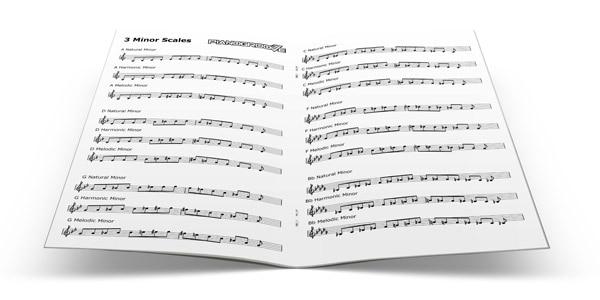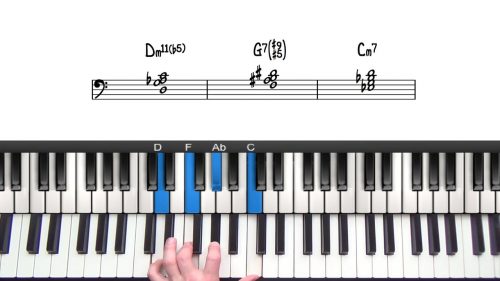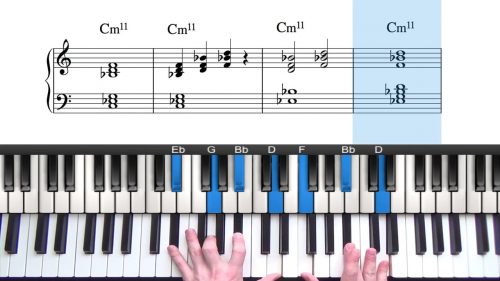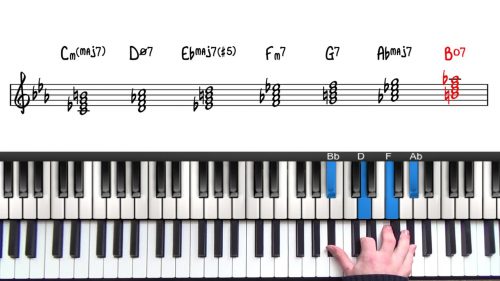Minor Scales Jazz Piano Tutorial
There are three types of minor scale: the natural minor scale , the harmonic minor scale and the melodic minor scale. Each minor scale has a different use and application in jazz piano and so learning how to construct and apply each one is a vital skill.
Similar to learning 7th chords, at this stage do not worry about memorising the 3 different minor scales in all 12 keys, this will come with time. However, ensure that you understand the formulas to construct each minor scale and why and how each scale is used in jazz piano.
In the upcoming beginner courses we will learn how to construct the minor 251 progression using the harmonic minor scale.
What Is The Natural Minor Scale?
The natural minor scale – also known as the relative minor scale – is a 7 note scale which contains a minor 3rd, a minor 6th, and a minor 7th. The natural minor scale is most likely the first minor scale that you will come across. The natural minor scale contains the exact same notes as the major scale that starts a minor 3rd above.
Above we can see the C Natural Minor Scale and the characteristic notes of the scale are highlighted in red. The single note that differentiates the natural minor from the other minor scales is the b6.
What Is The Harmonic Minor Scale?
The harmonic minor scale is the same as the natural minor scale but with a raised 7th degree. Raising the 7th degree by half a step gives the scale a much stronger harmonic foundation and allows you to create more interesting harmonic possibilities in minor keys.
The characteristic notes of the harmonic minor scale are the b6 in combination with the natural 7 as seen in the image above. The flatten 6th and natural 7th degree creates an ‘middle-eastern’ quality at the top of the scale which is a very distinctive sound.
To build a minor 251 progression, we must use notes and chords derived from the harmonic minor scale
The Melodic Minor Scale
Finally, the melodic minor is the same as the natural minor but with the 6th and 7th degrees raised. The raised 6th and 7th degrees removes any awkward intervals in the scale making it flow very smoothly.
This makes the melodic minor scale particularly suited to melodic development. In classical music, the melodic minor scale has a raised 6th and 7th ascending and then a flat 6th and 7th descending. In jazz we ignore this approach and play the scale the same ascending and descending.
Downloadable PDF Resource:
Download this printable lesson resource containing the 36 minor scales:
Lesson Downloads
-
36 Minor Scales Notation File Type: pdf
Practice Tips
The minor scales will take longer to learn that the major scales as there are 36 minor scales.
If you are just starting out, it is not vitally important to have all these scales memorized in every key. But you should understand the difference between the scales and know the formulas for constructing them:
- Natural Minor: major scale with b3, b6 & b7
- Harmonic Minor: major scale with b3, & b6
- Melodic Minor: major scale with b3
Considering you understand those 3 formulas, you now know how to construct the minor scales in all 12 keys.
Try to work out the scale using the formulas instead of becoming over-reliant on the notation. This gives us a functional understanding of the scales and the tones that they contain.










Hi Hayden, though I just started your online course I’m already addicted to it! I think it’s really great and quite understandable for a novice like me! But I already have a question. I just started the second lesson of the Jazz Piano Foundations course about the minor scales. When you’re talking about the natural minor scales you give the example of the G major scale and it’s natural minor scale. Above you write a scale in musical notes and there is written a F#, while on the piano part you write Gb. Why is that? Greetings, Joyce
Hi Joyce,
Welcome to PianoGroove Pro!
That’s great to hear you are enjoying the course so far… I will send you a personal welcome email shortly with some more information on how we can help you get started.
That’s a good question…. what you are seeing is ‘enharmonic equivalents’ – this basically means it’s the same note, but spelled differently.
The software I use to generate the light-up keyboard has 3 options for the black keys:
I chose to use ‘all flats’ because the majority of jazz standards are written in flat keys such as the keys of Bb, Eb & F and it’s much less common for jazz standards to be written in sharp keys such as the keys of B, E or A.
Because of this, the light up keyboard will get the right notes most of the time, but as you quite rightly pointed out, it is displaying the enharmonic equivalent of F# in the key of G Major.
So basically it’s just a limitation of the software I use. Unfortunately, the software cannot understand what I am playing 100% of the time. It will give you the right note, but just spelled differently.
I hope this helps… kinda confusing I know but hopefully that makes sense 🙂
Look out for an email from me.
Cheers, Hayden
Thank you so much, Hayden. This really makes sense! And, by the way, I’ve got your very welcoming mail. It sounds very nice and motivating. I’ll send you some information about my musical background. Have a nice day!
Hi Hayden, I just started the minor scale exercises. Thanks a lot for the great instructions. One question: is there any download PDF available with fingering information ? That would be great – I would like to start learning the scales with correct fingerings from the beginning. Bests, Olli.
Hi Olli 👋
My pleasure, glad you find these lessons useful 🙂
Here’s a link to scale fingering tables: https://spinditty.com/learning/Piano-Fingerings-For-Major-and-Minor-Scales-and-Arpeggios
Notice that you can group many scales together – because the layout on the keyboard is similar.
C, G, D, A & E – all have the exact same fingerings for both major and minor scales. This is important to remember and memorise and it will make your workload much lighter.
Bb and Eb have similar fingering.
and Ab and Db have similar fingering.
Gb / F# is the anomaly.
Try to make note of this.
Also another point is to remember that when improvising jazz, it’s not very musical to just run up and down scales. This is why I don’t place too much importance on learning the exact fingerings. Instead it’s common to play fragments of scale combined with arpeggios and other intervals.
To summarise, it’s certainly a good exercise to learn the correct fingerings, but don’t get caught up on this as there is much more to explore in the PianoGroove course.
I hope this helps and if I can be of further assistance just let me know 🙂
Cheers!
Hayden
Great ! Thanks a lot.
Bests, Olli.
Hi Hayden, I’ve recently signed up for the Jazz Piano Foundations class and am so far very excited with what I am learning! I cannot see the response you wrote to Olli Klein who was inquiring on fingers for minor scales… not sure why I can’t see some of the responses, but can see others. For example, I cannot see your response to Shantanu either… and several others. Is it a technical issue with the platform, or is there some other reason not allowing me to see the response? Thank you in advance!
Hi Maria,
Thanks for letting me know about this and yes indeed it was a technical bug. This has now been fixed so you will be able to read all of the comment replies.
With regards to minor scale fingering, I will create a lesson on this similar to the major scale fingering lesson.
As I mention in other comments, the most important thing is to learn and visualise scales numerically (ie. 1-2-3-4-5-6-7) and this sets the foundation for further harmonic study with chord extensions, chord alterations, and modal theory.
I will reply to this comment when the minor scale fingering tutorial has been added to this course
Let me know if I can help further and enjoy the lessons!
Cheers, Hayden
Thank you so much for the quick response, the fix and the future minor scale tutorial.
Fantastic lesson. I just realized the significance of the harmonic minor scale and the jazz sound associated with it
Thanks Sameer – great to hear you enjoyed the lesson.
Yes that’s right, the hamronic minor scale is very important to construct chords and progressions in minor keys such as the minor 251.
It’s also a brilliant sound in the right hand. Try playing G Harmonic Minor Scale over a 251 in G Minor which is A-7b5 – D7alt – and G-maj7
Check out this course for more information on the minor 251 progressions: https://www.pianogroove.com/jazz-piano-lessons/left-hand-voicings/
Cheers!
Hayden
Dear Guru,
Need your help to validate my understanding to ensure that I play the common scales in Blues major / minor improvisations correctly –
Natural Minor: major scale with b3, b6 & b7
Harmonic Minor: major scale with b3, & b6
Melodic Minor: major scale with b3
Dorian Minor: major scale with b3, & b7
Regards,
Hi Shantanu, Yes that is correct.
I have posted about this topic in detail in the forum. Check out the information in these 2 forum threads:
https://www.pianogroove.com/community/t/the-natural-6-13th-over-minor-chords/1572
https://www.pianogroove.com/community/t/practicing-minor-scales/2423
That will give you some more information on choosing between the minor scales, and how the different minor ‘colours’ can be used and applied.
I hope this helps and if you would like me to elaborate further just let me know.
Talk soon!
Hayden
What is the correct nomenclature name for the 2nd chord (D) built using C (harmonic) minor with an added 7th?
The basic triad is (I believe) Dm˚. Does it become a Dm7♭5?
Thanks!
Hi There!
Yes the 7th chord build from the 2nd degree of the C Harmonic Minor Scale would be D-7b5.
We would have D the root, F the minor 3rd, Ab the b5th, and C the minor 7th.
Check out the lesson on the minor 251 here: https://www.pianogroove.com/jazz-piano-lessons/minor-251-progression/ – We talk about the chords from the harmonic minor scale, in particular the ii-7b5 chord, the V7alt chord, the i-7 chord, and how all 3 of these chords create 251 progressions in minor keys.
That lesson should help with your understanding of minor harmony 🙂
Cheers, Hayden
I look forward to that.
Thanks
Anthony
Hi,
I have a question about how to think about the minor scales. In one place you say to build the harmonic from the natural, and then to build the melodic from the resulting harmonic. I just want to clarify the goal. Is it to think of the melodic as “the same notes as the major scale, but starting on the sixth degree, with the 6th and seven degrees raised a half step.” Or is the goal to simply understand that this is how the melodic scale is derived, and, in practice, I can simply think of the melodic minor as a major scale with a b3rd? Sorry if that is confusing. Thanks in advance.
Hi Colin,
Good questions.
I like to think of each minor scale as a different ‘colour’ that can be played over minor harmony.
Each minor scale has its own distinct ‘flavour’ and ‘character’.
We talk more about this in these forum posts:
https://www.pianogroove.com/community/t/practicing-minor-scales/2423/6
https://www.pianogroove.com/community/t/the-natural-6-13th-over-minor-chords/1572
https://www.pianogroove.com/community/t/minors-in-the-practice-guide/3005
Take a read over those posts, and if you have any further questions feel free to join in the discussion.
Cheers,
Hayden2
Thank you for the wonderful tips as to why these scales are important in jazz – Really have enjoyed this lesson. 🙂
Hi Tina 👋
That’s awesome, I’m glad you found the lesson and tips useful.
At this point, don’t fret over learning all 3 minor scales perfectly in all 12 keys. Right now, the most important thing is to understand the difference between the 3 minor scales, how to construct them numerically, and how each one is used in jazz.
As you progress through the syllabus you will gradually learn and memorise the scales in all 12 keys from playing songs and tunes.
Enjoy the lessons and happy new year!
Cheers, Hayden
Hi Hayden,
I am a beginner and I watched the lessons in Minor Scales and is a little confused as to how I should “organize” my understanding.
You picked a major key (say C key) and introduced that the natural minor starts from the 6th degree of this key and said that is the natural minor because they share the same notes. That’s ok and I understand. Then you tell us that how to derive the harmonic minor based on altering (flat or sharp) the notes based on the natural minor. So by changing the notes on a harmonic minor scale, we can get the melodic minor. Everything so far is based on C major key getting to it’s related minors keys which starts and end with an “A” note. The logic stacks up nicely and all sounds ok with me.
The confusion comes when you wrote in your Practice Tips telling us to use the formulas for constructing the different minor scales.
Nature Scale = Major Scale with b3, b6, and b7 Take a C major Key, using the formula, the notes become C, D, Eb, F, G, Ab, Bb, so this become a Cm scale which is the natural minor scale of Eb major key (not a C major key!). So what’s that got to do with the initial concept of “starting at the “6th degree” of a major scale?
I am not sure if you understand what i am trying to ask. And I don’t how to ask cos’ I am confused.
BTW, I like this course!!
Many thanks .
Best regards,
Lawrence
Hi Lawrence,
Good questions.
Firstly it’s important to memorise the relative major/minor pairs as this information can be used in many other areas of jazz theory. For example, we can use voicings from minor keys to voice chords in the relative major, check out this lesson where we use the minor “So What” voicing to construct a major 13 chord in the relative major key: https://www.pianogroove.com/jazz-piano-lessons/major-so-what-variation/ – memorising those pairs ‘opens doors’ later down the line which is why it was specifically mentioned.
Onto your next question, I find those minor scale formulas useful when choosing what ‘colour’ to apply over minor chords with my right hand lines and melodic ideas. If I want a mysterious sound over a minor chord, I just think major scale with the b3 which gives us the melodic minor. If I want something more ‘exotic’ sounding I might add the b6 which gives us the harmonic minor and creates that middle eastern flavour. I talk about this more here in the forum: https://www.pianogroove.com/community/t/the-natural-6-13th-over-minor-chords/1572
There are different ways that we can look at modes. Here is another related forum post which you may find useful:
https://www.pianogroove.com/community/t/minors-in-the-practice-guide/3005
Take a read over the forum threads above and that should give you some additional insight.
Let me know if you have any more questions and I’m here to help 🙂
Cheers, Hayden
Hi Hayden,
what about the minor harmony?
What are the chords of minor progressions?
I don’t know if I’m making myself clear, in major keys we know that 1 and 4 are major 7th, 5 is a dominant 7th, 2, 3 and 6 are minor 7th and 7 is half diminished. But in minor I’m lost and never know which chords I am supposed to find. I found very useful when I look at a new song to understand what is happening and when it is or goes to minor I feel lost, so my question is, which one of the three minor scales is used to harmonise minor music and what are the degrees ? 😉
Hi Frédéric,
Good question!
In the upcoming course on “Mastering Left Hand Voicings”, we have a dedicated lesson on the Minor 251 Progression which explains how to construct chords and progressions in minor keys.
Here is the lesson:
https://www.pianogroove.com/jazz-piano-lessons/minor-251-progression/
To answer your question:
We use the Harmonic Minor Scale to build chords in minor keys. The reason the scale is called the HARMONIC minor is because it gives us greater harmonic possibilities that the other 2 minor scales. The lesson above explains exactly why this is.
Similarly, the MELODIC minor scale is predominantly used for melodic development because the scale is best suited to creating melodies.
Check out the lesson above and let me know if you have further questions.
Cheers, Hayden
Thank you!
In this lesson you introduce the Natural Minor, Harmonic Minor and Melodic Minor scales.
Elsewhere in the course and comments I’ve seen reference to the Dorian but have yet to come across the lesson where this is defined. Is it another name for one of these scales, or is it something else entirely? Thanks!
Hi Phil,
Good question!
The Dorian Mode is the second mode of the major scale.
For example if we play the C Major Scale from D to D, we have the D Dorian Mode. The dorian mode is a very free flowing scale and it is often the scale of choice to improvise over minor chords, but the melodic and harmonic minor scale are also useful.
We can derive 7 modes from the major scale, the melodic minor scale, and the harmonic minor scale, and these modes are used extensively in modern jazz improvisation.
We look at the modes of the major scale and melodic minor scale in the course “Scales & Modes For Improvisation” – https://www.pianogroove.com/jazz-piano-lessons/scales-modes-improvisation/
Also check out these forum threads where we discuss minor scales and also the role of scales and modes in jazz improvisation:
https://www.pianogroove.com/community/t/the-natural-6-13th-over-minor-chords/1572
https://www.pianogroove.com/community/t/how-do-modes-relate-to-a-chord-progression-line-in-jazz-improvisation/1958
https://www.pianogroove.com/community/t/minors-in-the-practice-guide/3005
https://www.pianogroove.com/community/t/how-to-think-about-modes/2631
https://www.pianogroove.com/community/t/playing-over-chords/4716
Hope that helps Phil and let me know if you have any further questions.
Cheers, Hayden
HEllo, looking at fingerings for certain minor scales like G sharp or F sharp sometimes the melodic or natural are really strange. Is there specific fingerings for some of these scales
Hello! Is it mandatory to do rills with the left hand as well? Or it is more RH focused to practice minor scales? Thanks in advance.
Hi Oleg,
At this stage, I would recommend that you just focus on the right hand. Soloing and improvisation predominantly uses our right hand when playing jazz piano, and so it’s a good idea to learn and master the drills in your right hand first.
It’s not a bad idea to do the drills in your left hand, but I would recommend spending that time studying the lessons in the extended voicings course to improve your knowledge of jazz piano.
I hope that helps and any other questions just let me know.
Cheers, Hayden
Hi Hayden–I’m back to these terrific lessons after a forced interval, kind of starting over. My question is I can’t find the “homework” for the minor chords lessons on this page. The bit you mention at the end of the lesson, with written answers. Please advise. Many thanks, Bill
Hi Bill,
Thanks for getting in touch and welcome back!
Yes you will see the PDF download “36 minor scales” in the Downloads section of the page. This is the written notation or the “answers” as I mention in the lesson, but I also provide the ‘numerical formulas’ for constructing these scales in the “Practice Tips” section.
I mentioned in the lesson that you should memorise the formulas, and try not to simply read the notation in the PDF file, but rather with the formulas in mind, pick any key and try to find the minor scales just by looking at the piano.
On a related note, I recommend to check out the “Minor Harmony & Improvisation” course below and this will give you a more practical understanding of how and why these minor scales are used:
https://www.pianogroove.com/jazz-piano-lessons/minor-harmony-improvisation/
I also recommend that all students study the following 2 jazz standard courses in our beginner section in tandem with learning the theory here in the foundations course:
“Georgia On My Mind – Bluesy Stride” which will allow to see the many steps to learning a new jazz tune: https://www.pianogroove.com/jazz-piano-lessons/bluesy-jazz-piano-beginners/ watch the lessons in this course as a priority. This should be a good fit for you to see the process of learning a tune in jazz starting with diatonic harmony and then slowly introducing more sophisticated voicings and harmonies.
Also our course on “Cocktail Piano Improvisation” which focuses on the tune “Misty” – https://www.pianogroove.com/jazz-piano-lessons/cocktail-improvisation-for-beginners/ – Again it will help you understand the many ways that we can interpret a tune for solo piano and give you a template to learn improvisation over jazz ballads.
I hope that helps Bill, and let me know if you have any further questions.
Cheers, Hayden